 |
April 2013
|
April 2013 // Volume 51 // Number 2 // Tools of the Trade // v51-2tt2
Encouraging Rain Garden Installation with a Smart Phone App
Abstract
A smart phone mobile application (app) has been created to assist landscapers, contractors and home owners in designing, installing, and maintaining rain gardens. It seeks to address water quality issues by taking advantage of the rapidly increasing use of mobile devices to access educational information and complement existing in-person educational efforts to address water quality issues. In addition to a series of tutorials, the app includes several interactive tools to help users size their garden, evaluate their soils, and select proper plants. The initial version of the app is focused on Connecticut, but a national version is planned.
Using Mobile Technology to Expand Program Reach
Rain gardens are vegetated depressions in the landscape designed to collect and infiltrate stormwater. They are a low-impact development (LID) or green infrastructure practice, which helps preserve the pre-development hydrology of a site. There has been great interest in these practices among the public as well as among municipalities that are encouraging or even requiring their use to help meet water quality goals. The challenge is ensuring that these practices are installed correctly so they function as intended.
Many Extension programs around the country have focused on training landscapers and others on proper rain garden design and installation. Such training often involves classroom and hands-on field installations of rain gardens, with brochures, guidebooks, or printed presentations as “take-home” materials. Although popular, there is a limited capacity to reach stakeholders with this types of in-person training. The Extension program at the University of Connecticut is trying another approach to supplement these workshops by developing an educational smart phone app.
Apps are software applications designed for use in a mobile operating system. Given that 46% of all American adults now own a smart phone (Smith, 2012) and half of adult cell phone owners have apps on their phones (Purcell, 2012), mobile technologies are fast becoming a primary way users obtain information. The utility of mobile applications for Extension has been highlighted in a recent article (Drill, 2012), and an app has already been developed to aid Extension outreach for turfgrass (McCullough, Waltz, Hudson, & Martinez-Espinosa, 2011). Among cell phone owners with apps, 64% have downloaded educational apps, the third highest category (Purcell, 2011).
An in-the-field resource such as an app can help ensure that rain gardens are designed, installed, and maintained properly. Landscapers or contractors may not bring a rain garden brochure to the job site with them, but they are very likely to bring their phone. The Rain Garden app is intended to reinforce lessons learned during an in-person workshop, but it can also be used as a stand-alone resource. Connecticut Sea Grant funding was obtained to develop this app. Three Extension faculty developed the content, and a PhD student in Computer Science at UConn was paid to build it. This project highlighted the multiple benefits that can be realized as a result of using university resources. Programming costs were kept low, and the student gained valuable real-world experience. These types of opportunities should not be overlooked at educational institutions.
What the App Does
The app provides information on how rain gardens work and how to design, install, and maintain them (Figure 1). It includes short (<3 min) videos to drive home key points, as well as several tools to aid in sizing rain gardens, determining soil suitability, and selecting plants. The Basics section has information for those unfamiliar with rain gardens, such as what they are, how they work, and some example photos. The Design section has detailed guidance on how to site a rain garden, test the soils, and properly size a garden.
Figure 1.
Home Screen of Rain Garden App
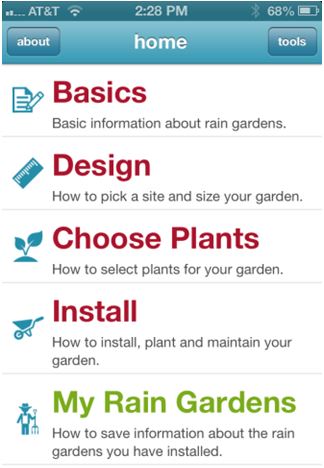
Two tools are available to determine how big a garden should be for a particular site. The user can enter the dimensions of the roof or paved area draining to the garden, and the app will calculate the best rain garden size (Figure 2a). Alternatively, the user can zoom to their location on an imagery map, tap to outline the shape of the area draining to the garden, and the app will calculate the size (Figure 2b).
Figure 2.
Rain Garden Sizing Via Measurement (a), and Mapping (b)
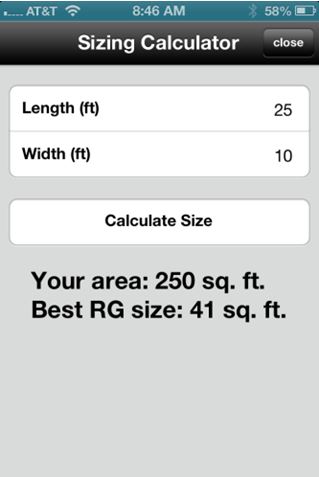
(a) Rain Garden Sizing Via Measurement
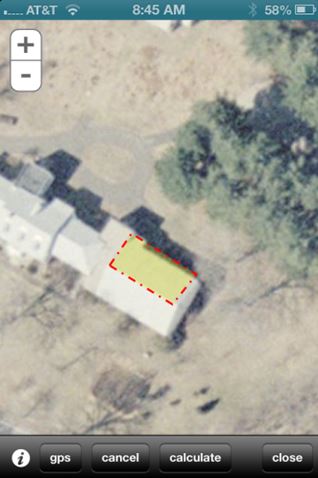
(b) Rain Garden Sizing Via Mapping
Determining the permeability of soils at a site is a critical step in making a rain garden successful. The Design tab also has a tool to check your soil drainage potential at your location. The map uses the soil drainage class from the national USDA soils database, and it gives users a general idea of what the soils are like at their location (Figure 3).
Figure 3.
Soil Drainage Map (a) and Legend (b)

(a) Soil Drainage Map
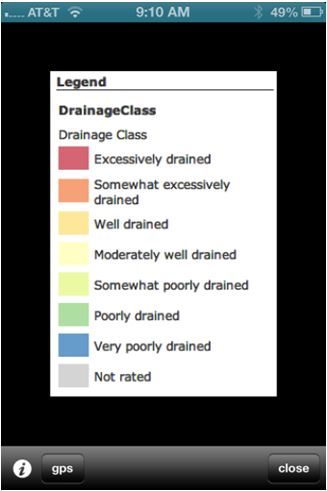
(b) Soil Drainage Legend
Another challenge to installing rain gardens is selecting plants that will do well. The Choose Plants tab includes a plant database of natives or well-adapted non-native plants. The user can select attributes such as sun exposure, type of plant (e.g., perennial, grass, tree), and bloom color (Figure 4a) and get a list of corresponding plants, including a thumbnail image of the plant (Figure 4b). Selecting the individual plant provides more detail on that plant and a link to a gallery of images (Figure 5). Users can then select the plants they like and add them to their plant list.
Figure 4.
Plant Selection Options (a) and Sample List (b)
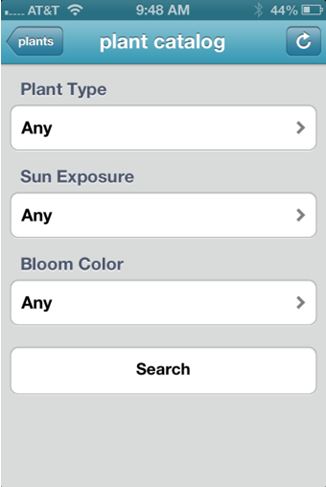
(a) Plant Selection Options
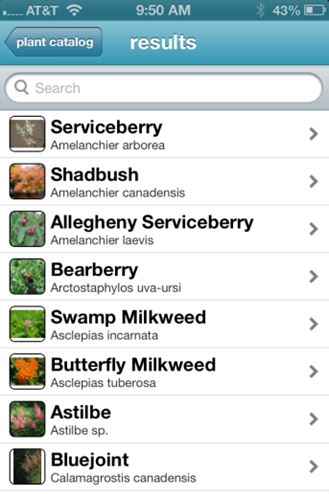
(b) Sample List
Figure 5.
Detail Screen for Each Plant
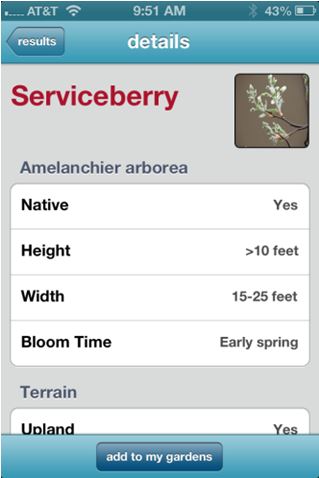
The Install section has guidance on how to do the actual rain garden installation, including advice on Call Before You Dig utility marking, tools to choose, how to properly do the installation, and how to plant. There are also short video clips available here and in several other places to help guide users through key concepts such as choosing a location, soil percolation testing, installation, and planting.
The My Rain Gardens section allows users to organize multiple rain gardens. Plant lists, rain garden size, and maintenance reminders can be saved and managed through this tab. Additionally, users will be able to export key information about their gardens to Extension faculty at UConn Center for Land Use Education and Research (CLEAR). This will allow for detailed tracking of rain garden installations and eventually enable us to quantify stormwater volume treated by rain gardens in the state, as well as estimate pollutant load reductions.
Conclusions and Future Directions
This educational tool will provide landscape professionals, homeowners, and others with the on-the-go information to design, install, and maintain rain gardens effectively. The Rain Garden app is currently tailored to CT, but a national version is in the works that will modify soils and plants based on a user’s location. It is currently available for iPhone users; an Android version is scheduled to be released by May 2013. Information on the app can be found at the NEMO website (http://nemo.uconn.edu/tools/app/raingarden.htm).
References
Drill, S. L. (2012). Mobile applications for Extension. Journal of Extension [On-line], 50(5) Article 5TOT1. Available at http://www.joe.org/joe/2012october/tt1.php
McCullough, P. E., Waltz, F. C., Jr., Hudson, W., & Martinez-Espinosa, A. D. (2011). Turfgrass management at your fingertips: Information delivered through "smart" phone technology. Journal of Extension [On-line], 49(3) Article 3TOT10. Available at http://www.joe.org/joe/2011june/tt10.php
Purcell, K. (2011). Half of adult cell phone owners have apps on their phones. Pew Internet and American Life Project. Mobile Report. Retrieved from: http://pewinternet.org/Reports/2011/Apps-update.aspx?src=prc-headline
Smith, A. (2012). Nearly half of adult cell phone owners have apps on their phones. Pew Internet and American Life Project. Mobile Report. Retrieved from: http://pewinternet.org/Reports/2012/Smartphone-Update-2012.aspx




